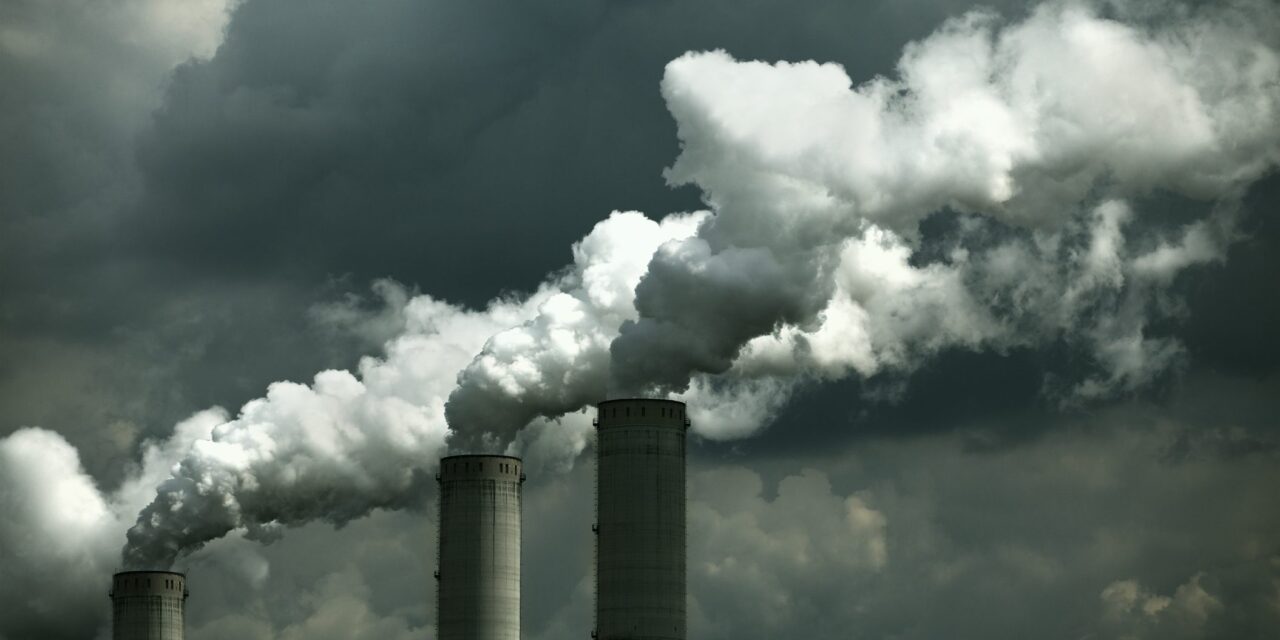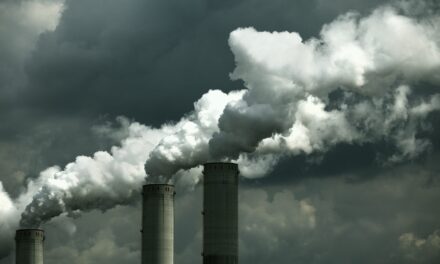Who knew Al Gore didn’t invent man made global warming created by greenhouse gases as part of a scheme to destroy America and mach himself and a few greedy scientists rich? Well, Scientists back in the 1950’s knew, that’s who. When Al Gore was 8 years old this news recording was made demonstrating a John Hopkin’s physicist, Gilbert Plass, was already speaking out about global warming as a result of industrial activity. Here’s a GE radio show explaining Plass’ research:
As the video shows, Plass, had already pinpointed carbon dioxide as the primary culprit. Plass was no crank. He was a respected physicist who was hired by the Defense Department to work on the development of heat seeking missiles.
Here’s a brief discussion of Plass’s career as a physicist at Wikipedia:
Plass worked most of his life as a physicist in the United States. He graduated from Harvard University in 1941 and earned a Ph.D in physics from Princeton University in 1947. He worked as an associate physicist at the Metallurgical Laboratory (Manhattan District) of the University of Chicago from 1942 to 1945. He became an instructor of physics at Johns Hopkins University in 1946, and eventually became an associate professor there. In 1955, leaving academics, he held a job for a year as a staff scientist with Lockheed Aircraft Corporation. He then joined the advanced research staff at the Aeronutronic division of the Ford Motor Company. In 1960, he became manager of the research lab at Ford’s theoretical physics department and a consulting editor of the journal Infrared Physics (now called Infrared Physics and Technology). In 1963, he accepted a position as the first professor of atmospheric and space science at the Southwest Center for Advanced Studies (now the University of Texas at Arlington), where he remained for five years. In 1968, he arrived at Texas A&M University, where he served as professor of physics and head of the department.
In 1956 and onwards Plass published a series of articles on the effects of CO2 as a greenhouse gas, and the potential implications of an increased concentration of carbon dioxide in the atmosphere for global warming. The articles were partly based on advanced calculations of the absorption of infrared radiation, and Plass made use of early electronic computers. He predicted that a doubling of CO2 would warm the planet by 3.6ºC, that CO2 levels in 2000 would be 30% higher than in 1900 and that the planet would be about 1ºC warmer in 2000 than in 1900. In 2007 the IPCC Fourth Assessment Report estimated a climate sensitivity of 2 to 4.5ºC for CO2 doubling, a CO2 rise of 37% since pre-industrial times and a 1900-2000 warm-up of around 0.7ºC
Plass’ prediction of warming as a result of CO2 in the 1950’s was amazingly prescient considering he worked at a time when the computing power of a single microchip exceed the then existing room sized mainframe computers on which IBM made its fortune. So, the science of Climate change isn’t the creation of a worldwide conspiracy of lying liberal money grubbing anti-capitalists who want to steal your freedoms. It was well known fact that the earth was warming and that increased carbon emissions by human activity was the likely culprit. As the GE program demonstrates, trhe theory of greenhouse gases creating warming and climate change was a well respected theory in the very year I was born.
Here’s a discussion of Plass’s work from Real Climate:
Gilbert Plass was one of the pioneers of the calculation of how solar and infrared radiation affects climate and climate change. In 1956 he published a series of papers on radiative transfer and the role of CO2, including a relatively ‘pop’ piece in American Scientist. … Some of the intriguing things about this article are that Plass (writing in 1956 remember) estimates that a doubling of CO2 would cause the planet to warm 3.6ºC, that CO2 levels would rise 30% over the 20th Century and it would warm by about 1ºC over the same period. The relevant numbers from the IPCC AR4 are a climate sensitivity of 2 to 4.5ºC, a CO2 rise of 37% since the pre-industrial and a 1900-2000 trend of around 0.7ºC.
To understand if Plass should get full credit, we need to see his workings. These are mainly outlined in two more technical papers in Tellus and QJRMS earlier that year. In today’s parlance, Plass calculated the change in top-of-the-atmosphere (TOA) radiative fluxes given a doubling (or a halving) of CO2 while everything else stayed the same. He then took that number and using someone else’s estimate of the sensitivity of the TOA radiation to the surface temperature, he calculated the temperature change that would be necessary to compensate. Converting from the units he used, the radiative flux values for a doubling of CO2 were 8.3 W/m2 and 5.8 W/m2 for clear-sky (no clouds) and averagely cloudy conditions (all-sky) respectively (and slightly larger and of opposite sign for a halving). The sensitivity of the TOA flux to surface temperature he used was around 2.3 W/m2 per ºC (equivalent to a temperature sensitivity of 0.4 ºC/(W/m2)). However, this is a ‘no-feedback’ estimate (allowing only the surface temperature to change with a constant lapse rate, but with no changes to water vapour, albedo or clouds).
Today, our current best guess for the forcing due to 2xCO2 is around 4 W/m2, and the ‘no-feedback’ sensitivity is around 0.3 ºC/(W/m2), giving an expected no-feedback temperature change of about 1.2 ºC, a factor of 3 smaller than the number Plass quoted, though since our number is for ‘all sky’ conditions, it would be a little better to compare it to his averagely cloudy number 2.5 ºC (so a factor of two higher). Note that Plass was a little casual in how he described his numbers and the ‘clear sky’ designation for the 3.6ºC number was not always made clear. However, Plass was well aware that the ‘no-feedback’ case was unrealistic and estimated that the water vapour, cloud and ice-albedo feedbacks would be amplifying, although he was not able to quantify them.
Moving now to the rate of change of CO2 in the atmosphere, Plass made a very good estimate as to how much human emissions of CO2 were increasing. His estimate was (again, in modern units) that then-current emissions were 1.5 GtC based on earlier estimates from Callendar, which actually was an underestimate. Our current best estimate for the anthropogenic emissions in 1956 is about 2.2 GtC. Given the increasing nature of the emissions, Plass then estimated that concentrations would rise about 30% by the end of the 20th Century. This however needs an estimate of how much of the emissions would be absorbed by the oceans and biosphere. Here, Plass has another impressive insight that the ocean chemistry would prevent quick uptake of the human CO2, a concept that wasn’t fully worked out until Revelle and Suess’s paper in 1957 (though possibly he may have been aware of some informal communications earlier). Plass actually assumed that none of the CO2 would be taken up in the short term. So his 30% growth estimate (the actual rise was 36%) was derived from an underestimate in emissions (and emissions growth) combined with an overestimate of the ‘airborne fraction’ (which is roughly 40% of total emissions).
I suppose that Plass would be called an alarmist today, but his back of the envelope, pre-supercomputer predictions regarding the increase of man-made CO2 and its effect on climate were quite extraordinary considering how much more data and evidence we have today to support his theory. Certainly he was considered a prominent and respected scientist considering his academic career and his recruitment by Lockheed and the Defense Department in the early to work on the national defense issues.
What is truly frightening is that here we are today, more than fifty years later, and still a few highly paid “skeptics” still denying what Gilbert Plass knew and fairly accurately predicted back in 1956, the year I was born. Plass was not a genius on the scale of an Einstein, but he knew enough from the historical record that existed over 54 years ago that mankind was playing with matches by continuing to rely on the burning of coal and oil the primary fossil fuels we continue to consume at ever increasing rates.
Of course, he wasn’t a lone voice in the wilderness before Al Gore suddenly appeared on the scene. When Gore was 31 years old, a young Stephen Schneider in 1979 predicted an exponential increase in carbon emissions from humanity’s use of fossil fuels.
Schneider went on to have a distinguished career as a climate scientist and died only recently. Here is a eulogy of him as a man and a scientist by Ben Santer:
Steve had the rare gift of being able to explain the complexities of climate science in plain English. He could always find the right story, the right metaphor, the right way of distilling difficult ideas and concepts down to their essence. Through his books, his extensive public speaking, and his many interactions with the media, Steve did for climate science what Carl Sagan did for astronomy.
But Steve was not only the world’s pre-eminent popularizer of climate science. He also made remarkable contributions to our scientific understanding of the nature and causes of climate change. He performed pioneering research on the effects of aerosol particles on climate. This work eventually led to investigation of how planetary cooling might be caused by the aerosol particles arising from large-scale fires generated by a nuclear war. This clear scientific warning of the possible climatic consequences of nuclear war may have nudged our species onto a different – and hopefully more sustainable – pathway.
Steve was also a pioneer in the development and application of the numerical models we now use to study climate change. He and his collaborators employed both simple and complex computer models in early studies of the role of clouds in climate change, and in research on the climatic effects of massive volcanic eruptions. He was one of the first scientists to address what we now call the “signal detection problem” – the problem of determining where we might expect to see the first clear evidence of a human effect on global climate.
After spending many years at the National Center for Atmospheric Research in Boulder, Steve moved to Stanford in 1996. At Stanford, Steve and his wife Terry Root led ground-breaking research on the impacts of human-caused climate change on the distribution and abundance of plant and animal species. More recently, Steve kept intellectual company with some of the world’s leading experts on the economics of climate change, and attempted to estimate the cost of stabilizing our planet’s climate. Until his untimely death, he continued to produce cutting-edge scientific research on such diverse topics as abrupt climate change, policy options for mitigating and adapting to climate change, and whether we can usefully identify levels of planetary temperature increase beyond which we risk “dangerous anthropogenic interference” with the climate system.
Steve Schneider helped the world understand that the burning of fossil fuels had altered the chemistry of Earth’s atmosphere, and that this change in atmospheric composition had led to a discernible human influence on our planet’s climate. He worked tirelessly to bring this message to the attention of fellow scientists, policymakers, and the general public. His voice was clear and consistent, despite serious illness, and despite encountering vocal opposition by powerful forces – individuals who seek to make policy on the basis of wishful thinking and disinformation rather than sound science.
It should be noted that he served as a science adviser for every President since Nixon, which includes every Republican President. Sadly, none of them, despite his warnings and the threat posed to our national security from America’s reliance on fossil fuels, never effectively put into practice a plan to limit our dependence on them as our nation’s primary energy source.
When you have Republicans like Joe Barton apologizing to BP for Obama’s criticism of BP’s reckless and dangerous off shore well operations that cost us billion of dollars and devastated the ecosystems upon which the lives of people in the seafood and fishing economy of the Gulf Coast depended, that should come as no surprise.
When Republicans tout their objective to hold hearings to investigate “scientific fraud” in the field of climate science, and Republican James Inhofe calls on the Department of Justice to begin a criminal investigation of the leading scientists in the field, that also should come as no surprise.
When Republicans push an energy policy that is heavily reliant on increasing off shore drilling and hydrofracking despite the risks to our environment on land and sea, that again, is not a shock.
That respected scientists were pointing to CO2 as the principal culprit in global climate change more than half a century ago, though, belies their nonsense and exposes their hypocrisy. They depend on the corporate money of Big Oil and Big Coal. They could give a rat’s ass about what is happening to this planet because of their corporate paymasters activities. As long as the money keeps flowing into their political campaign and they can become rich lobbyists when they resign from Congress they could care less what happens to us and our children and grandchildren. They have sold their souls and sold them cheaply for paltry sums compared to the profits the fossil fuel industry makes every year.
For more than fifty years they Big Oil and Coal, and their many minions, have lied to us (and perhaps in rare instances lied to themselves) that the real villains are not a TRILLION DOLLAR industry and the numerous billionaires that industry has created at the expense of our health, our drinking water, our lives and our planet.
As Bill Moyers stated: Welcome to the Plutocracy and among our Corporate Overlords none is bigger than the Fossil Fuels Industry.
I wonder if Gilbert Plass predicted that back in 1956, too.





